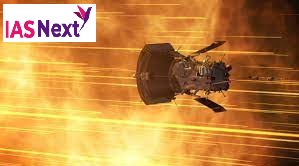CURRENT AFFAIRS
Get the most updated and recent current affair content on Padhaikaro.com
NASA’s Parker Solar Probe
- IAS NEXT, Lucknow
- 03, Dec 2021

Reference News:
The NASA probe recently made an extremely close encounter with the Sun. The probe was just 5.3 million miles away from the surface of our star and passed by at a ridiculous speed of 363,660 mph, making it the fastest artificial object ever created.
- Additionally, the Parker Solar Probe also broke the record for the closest satellite to survive a near pass of the Sun.
What next?
The probe will continue to orbit and increasingly get closer to the Sun, eventually coming within 4.3 million miles from the surface at speeds above 430,000 mph. With each pass, the probe collects valuable data about our star and relays the information back to Earth for scientists to interpret. Information regarding solar wind, and the amount of dust particles in the area are two main sets of data the probe collects.

About the mission:
- NASA’s historic Parker Solar Probe mission will revolutionize our understanding of the sun, where changing conditions can propagate out into the solar system, affecting Earth and other worlds.
- Parker Solar Probe will travel through the sun’s atmosphere, closer to the surface than any spacecraft before it, facing brutal heat and radiation conditions — and ultimately providing humanity with the closest-ever observations of a star.
Journey:
- In order to unlock the mysteries of the sun’s atmosphere, Parker Solar Probe will use Venus’ gravity during seven flybys over nearly seven years to gradually bring its orbit closer to the sun.
- The spacecraft will fly through the sun’s atmosphere as close as 3.9 million miles to our star’s surface, well within the orbit of Mercury and more than seven times closer than any spacecraft has come before.
Parker Solar Probe has three detailed science objectives:
- Trace the flow of energy that heats and accelerates the solar corona and solar wind.
- Determine the structure and dynamics of the plasma and magnetic fields at the sources of the solar wind.
- Explore mechanisms that accelerate and transport energetic particles.